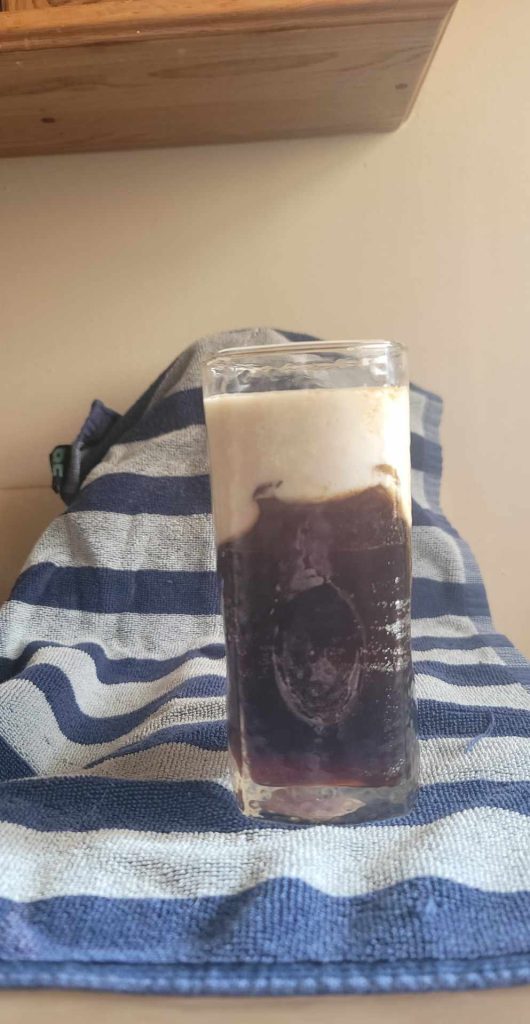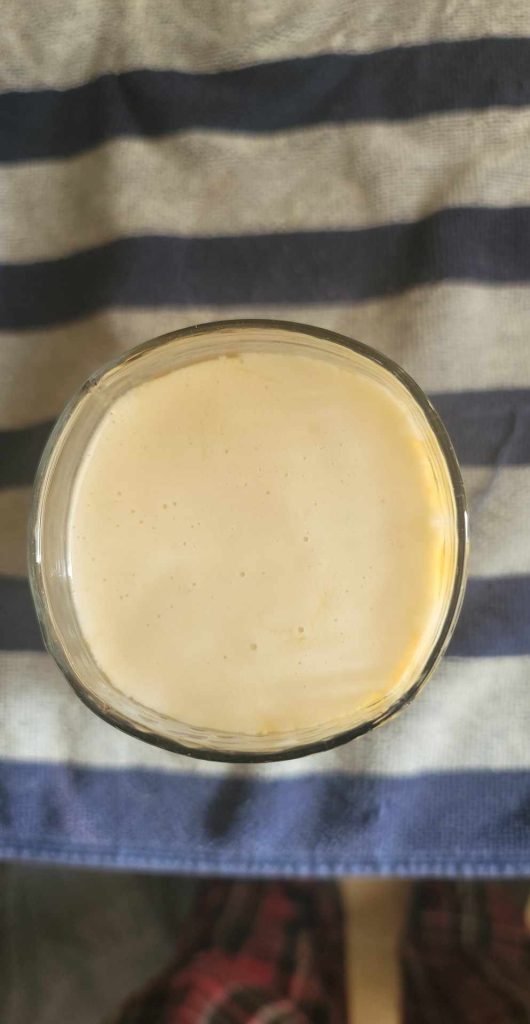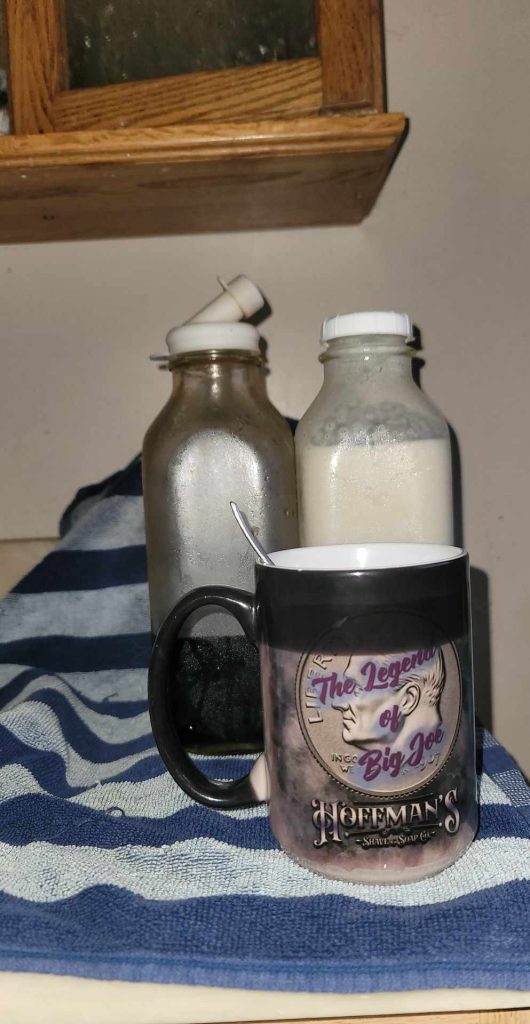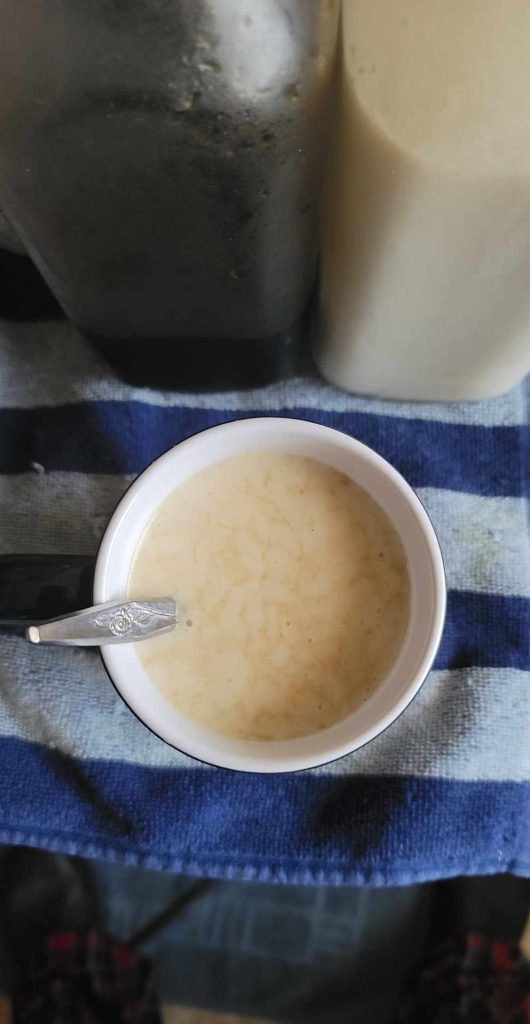LAB NOTES: Super Creamy Split Pea Milk TakeTwo: Yellow Split Peas.

Hello all, Wayne AKA The Mad Food Scientist here.
I’m revisiting split pea milk again. This time with yellow split peas. First a quick recapitulation.
Since I began using plant based milks, then later making them myself. I have found that milk made from split peas to be my favourite plant based milk.
I began with green split peas, but found some yellow split peas to use. I originally looked into milk from split peas after a discussion on Quora about split pea milk having a protein content at the same level
as cow’s milk. I was interested in it, but my local grocery store doesn’t carry it. So, off to YouTube I went searching for a way to make it at home. I found quite a few, but the majority of them didn’t make sense
when the instructions said to cook the split peas before turning them into milk. Then I found Falafelzebub’s channel and her recipe for making milk from split peas. I followed it and prepped one cup of split peas for each of the litres of milk that I planned on making. The first time I made it, I had to dilute it a lot to get it so I could pour it out of the milk bottle. It was that thick and it’s creaminess beat that of oatmilk made with double the oats than I normally would put in the oatmilk. ( 2 cups versus 1 cup per litre of milk desired ). Then I tried again, this time with a half cup of split peas per litre of milk that I wanted to make. It was very creamy, but also very thick and it too needed to be diluted. The third time that I made milk from split peas. I prepped a quarter cup of split peas for each litre of milk that I wanted to make. Nearly perfect! However, I still needed to add more water and now, I began getting three litres of this great milk out of a half cup of split peas. Well, it turns out more dilution was needed. So, about a month ago, I began adding an extra litre of water to avoid having to dilute milk after making it. So, now 113g of split peas is yielding four litres of milk.
I’m giving a shoutout to Falafelzebub for their recipe. The link for their blog post is below.
Here you go! I found this pea milk recipe on YouTube on the Falafelzebub’s Den Of Vegan Iniquity channel. ( LINK HERE: https://youtu.be/iBzUoXqDwVI ) The original recipe that I followed is on Falafelzebub’s blog. (LINK HERE: https://falafelzebubskitchen.blogspot.com/2022/02/pea-milk.html ).
ORIGINAL from Flafelzebub’s blog:
INGREDIENTS:
1 cup dry split yellow peas
enough water to cover
3 cups water
METHOD:
Soak peas in room temperature water to cover for eight hours or overnight.
Rinse and drain in a colander placed in the sink. Add drained peas to a blender, along with the fresh water. Puree until smooth, about one minute. Using a nut milk bag, cheesecloth, or fine strainer, strain. Reserve the pea solids in the nut milk bag for use in soups or stews..In a saucepan over medium heat, cook the pea milk for thirty minutes. Allow to cool.
Store the milk in a covered container in the refrigerator for up to five days.
Enjoy!
LAB NOTES: 09 September, 2023
INGREDIENTS:
113g Split peas Falafelzebub’s recipe said to use yellow split peas, but my local store only has green split peas.
4 litres of cold chilled water.
60g toasted sunflower seeds
1 big pinch of sea salt, or kosher salt
7.5g of Xanthan gum
3g of baking powder
3 TBSP Sunflower seed oil.
EQUIPMENT:
1 Blender with jar
1 Large mixing bowl
1 smaller mixing bowl
1 saucepan
1 spatula, silicone
2 4 or 8 cup measuring cups.
1 collander
1 wire mesh strainer
1 fine mesh strainer
3 1 litre milk bottles with lids
1 funnel
1 1/4 tsp measuring spoon
1 1 tsp measuring spoon
1 heat source
METHOD:
Soak the split peas 24 hours in a lot of cold water and 1 tsp of baking powder
Toast and soak the sunflower seeds in hot water the day of.
Drain and rinse both the split peas and the sunflower seeds.
Add to the blender jar.
Add the big pinch of salt.
Add 3 cups of water
Blend for at least three minutes
I did three straining passes.
1. Strain through the collandar twice, adding a cup of water for each straining.
2. Through a fine mesh strainer twice, adding a cup of water for each straining as well
3. Through an even finer mesh strainer twice, again adding another cup of water for each straining.
( So far 9 cups of water )
Put the milk into a saucepan and bring to a simmer, be very careful NOT to let the milk get too hot and scorch.
Bring it to a simmer, and then lidded it and dropped the heat.
I simmered the milk for 30 minutes, stirring occassionally.
Once the milk was done simmering, I divided it into three. I put three cups of milk into the blender jar
Then I added 1 cup of cold water, 1 TBSP of sunflower seed oil, 1/4 tsp of baking powder and 1 tsp of Xanthan gum to each jar..
Then I blended the milk for three and a half minutes.
I repeated the process for the other portions of the milk.
Then I put all the milk back into my mixing bowl before I divided a 1 litre milk bottle of water between the four milk bottles. I poured it into bottles.
I filled four 1 litre bottles then covered the bottles with a tea towel to allow the milk to cool to room temperature.
Once cooled, I capped and refrigerated the milk.
WHAT I DID:
I started the 113g of split peas soaking with cold water and a teaspoon of baking powder in a 1 quart Mason jar on 08 September, 2023.
I had yellow split peas and used them.
The reason that I started soaking them when I did was that I use a trick I picked up from the Mediterranean Dish’s hummus recipe,
Now that it’s been at least twenty four hours, I drained and rinsed the split peas. drained and rinsed the sunflower seeds. I added the drained split peas and sunflower seeds to the blender jar with a hefty pinch of sea salt. Initially, I put three cups of water in the blender then blended for two minutes. Then I strained the solids out of the mixture and added another cup of water at each stage of straining. I did the straining passes. Twice through the colander, twice through a fine mesh sieve, and twice through an even finer mesh sieve.. Alternatively, a nutmilk bag, or layers of cheesecloth can be used to strain. Then put the nine cups of milk into a saucepan and brought it up to a simmer. I lidded it and dropped the heat. I simmered the milk for 30 minutes, stirring occasionally. Once I was done simmering the milk. I divided it into three portions. I put a portion nto the blender jar and added 1 tsp of Xanthan gum, 1/4 tsp of baking powder, and 1 TBSP of sunflower seed oil. I blended the milk for three and a half minutes. before I divided a 1 litre milk bottle of water between the four milk bottles. I poured it into bottles. I filled four 1 litre bottles then covered the bottles with a tea towel to allow the milk to cool to room temperature.
Once cooled, I capped and refrigerated the milk.
I’m thankful to Mark at The Sauce Stache channel, Inga at the Healthy Origins channel and Falefelzebub from the Falafelzebub’s Den Of Vegan Iniquity channel for the kitbash of the recipe/method that I use.
If you’ve read the Oatmilk post ( The initial post on this blog ) you’ll notice a huge similarity. That’s because the method for all the plant based milks that I make is very similar with tweaks added as needed.
CONCLUSIONS:
This milk is rich, creamy and very versatile. As I’ve mentioned, I’ve baked and cooked with this milk, baked with it, and use it in hot drinks like coffee. It also makes a very nice hot cocoa. One thing I’d like to shine a light on is how this milk makes a very, very nice buttermilk substitute.
In future, I may revise my straining procedure. I’ll try subbing in a nutmilk bag for the last two straining passes. Also, in future, I may add the extra litre of water while straining rather than at the end. The reason I added it at the end this time is because I hadn’t initially planned on making four litres. You may ask why I add water to the blender jar? I do so to begin cooling down the milk after simmering.
The extra effort is worth the result. At less than $1.00USD for four litres it is very much more affordable than the Oatmilk I see in the store.
I cannot compare my cost to locally available commercially made pea milk, but I did a cursory search on Amazon and pack of six 1 litre cartons of shelf stable Ripple Pea Protein Milk costs approximately $29.35USD or about $4.89USD per litre I did a quick search on the UK version of Amazon and found Sproud on offer for £16.49GBP for six 1 litre cartons, or £5.50GBP per litre.
I don’t foresee purchasing commercially made plant based milks, not when making them myself is fairly straightforward.
The slight bean-y taste to this milk, is less than that of the milk made with green split peas. I don’t notice the bean-ey taste. Then again, I don’t drink it straight. I always add it to other things.
I will definitely continue making and using this milk. I encourage you to give it a try.
Finally, I’ll go against what your parents used to din into your ears.
Get in your kitchen and PLAY with your food!



mug.
